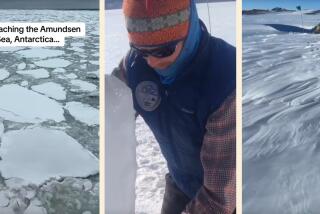Red or blue, there’s salvation in green
- Share via
Chihuahua Valley, San Diego County — BEFORE WE GET TO THE WHITE HOUSE AND I START complaining, flash back with me. It’s the morning after the election. A 30-year-old postdoctoral researcher named Yufu Cheng and two of his colleagues say goodbye to their wives and kids in the Los Angeles area, pile into a van, then aim it east. They have foliage to inspect.
Deep into the hills they drive, until about 30 miles southeast of Temecula the pavement ends. Now they lurch and jounce a few miles more up Chihuahua Valley Road, past horse ranches and hermits’ hovels.
At last they reach the Sky Oaks Research Station, a ragged compound on the low slopes of a broad, fire-scarred valley. No melancholy sycamore here, no blazing maples. Just charred oaks, skeletal manzanita and a million tufts of young brush.
They approach a grim little trailer and toss their sleeping bags in. They drag out a strange set of tools and saunter off to poke, scrape and measure the dirt and brush, then retreat to the grim trailer for dinner and a few rounds of hangman.
The next morning, early, I find them in the field again. One guy plucks the shoots of young, green chamise and red shank chaparral, and passes them to a second guy, who tucks them one by one into labeled phials and drops the phials into a freezing nitrogen canister. Once, twice, 18 times. Meanwhile the third guy crouches in the dirt, running a $35,000 machine that could pass for one of those fancy new vacuum cleaners that don’t lose suction. He’s measuring photosynthesis. Later, back in the office at Cal State L.A., they’ll huddle with biology professor John A. Gamon and compare findings with readings taken from planes and satellites.
This is leaf-peeping gone pro. Chen and company are here every two weeks, measuring with this and a dozen other machines, including a set of sensors that roll down a 100-meter track and back, taking readings every meter.
“This is one of my favorite machines. It’s never given me trouble,” says Cheng, hunched in sweatshirt and shades over the photosynthesis machine.
Alongside him stoops Loren MacKinney, a 52-year-old engineer, and Zhiyan Mau, a 33-year-old technician and computer specialist. They’ve been having trouble with a motor.
“Controller is out,” sighs MacKinney. “Fried. Toast. Slag.”
This is a handy tutorial in American slang -- Chen and Mau arrived here from China six years ago -- but also a large problem. This is a machine central to their project, and once you look closely at that work, you realize the planet is at stake.
This gang is here to learn how a plant’s color and moisture levels tie in with its absorption and expulsion of carbon dioxide. In other words, how the planet breathes. As civilization spits out carbon dioxide, temperatures climb, icepacks dwindle and leading scientists worry more and more about the connection between those events, these questions look more and more urgent.
But not for everybody. And so off to the White House.
If you’re a scientist who studies greenhouse gases, it’s no fun watching the U.S. president pull his country out of an international effort to reduce greenhouse gas emissions, as George W. Bush did in 2001. In backing away from the Kyoto Protocol that more than 100 nations have adopted, Bush cited inflated data and warned that reducing pollution would cut too deeply into U.S. businesses’ revenues.
He said the same on the 2004 campaign trail, and the release of two academic studies earlier this month -- each finding mounting consequences of global warming -- made no dent in his position.
On this morning in the backcountry, the election results aren’t final. But it’s clear that the Democrats will be wandering the desert for another four years. For these professional leaf-peepers, already afoot in their own wilderness, the news is as welcome as a fried controller.
“It’s very ... unusual,” said Cheng, who is not yet a citizen. “Because you’re working under a president who does not support your work. It’s not a good feeling.”
One thing about fieldwork though: It concentrates your thinking. When this project was born four years ago, the valley was studded with healthy oaks and manzanita and carpeted with chaparral. Then last July, a brush fire roared through, scorching 19,000 acres and reducing the test area to ashes and melted machinery.
The researchers’ response? They replaced their equipment and set about measuring the regeneration. Sixteen months later, the oaks and manzanita are still toast, but the more resilient chamise and red shank line the valley floor like lint from a vast green sweater. The data is rich and rewarding.
In the field, you take your victories where you can find them. And it doesn’t take them long to solve their motor controller troubles.
First the three scientists put their heads together and murmur a few minutes about “integration time” and such. Then they cut two lengths of string as guide lines and tie them on their rolling box full of sensors. Next, tiptoeing among the rocks, cactus and brush, they tug their sensors up and back along that 100-meter track.
Maybe they look a little silly, but they’ve found a work-around. Their mission moves forward.
So now I have a political question. It’s bigger than the backcountry and broader than global warming, but these guys have got me thinking. For 48% of us, the time has come to set up our own national work-around, and I’m ready to pull. Where do we attach the string?
To e-mail Christopher Reynolds or to read his previous Wild West columns, go to latimes.com/chrisreynolds.







